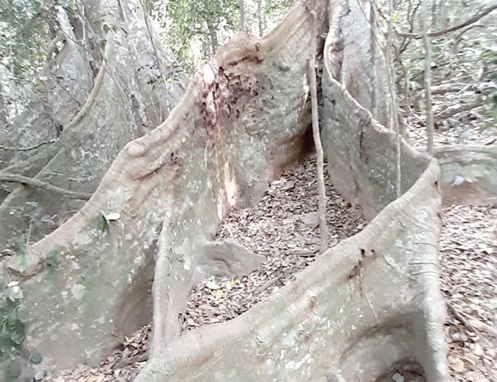
Bunso’s fishing canoe tree
Call it a naturally-formed fishing canoe in a forest and you will not be mistaken.
Advertisement
This is because the base of a 65.7-metre African Oak Tree with the scientific name Piptadiniastrum Africanum commonly called Dahoma within the Bunso Eco Tourism Park, has all the features of a fishing canoe.
Its big opening at the base, a replica of a canoe, can accommodate about eight persons at a time while its roots firmly support the tree from falling.
Canoe or wonder?
The tree, which the locals and tourists often refer to as a canoe or the "Wonder of Bunso”, is one of the leading tourist attractions in the Eco-Tourism Park. Every visitor, therefore, is eager to see what has been described as one of the wonders of nature.
Because of this, the tree has become "the Mecca" of the Eco Park which tourists or revellers have to at least touch before leaving the park. It is a tall deciduous tree of the legume family, native to the humid tropics, of which Ghana forms part.
The tree is very hard and usually used for wood works such as furniture. Due to its very hard nature, it is also used for the construction of rail lines or tracks and is in great demand.
Tourists
But because of its canoe-like nature, it has been preserved at the Eco Park to continue to draw a large number of tourists to the place. One of the tourists, Nkansah Agyapong, told the Daily Graphic that he was always visiting the Bunso Eco Tourism Park because of the wonderful canoe tree, during which he would take pictures to show to his kids one day.

The scientific name of the fishing canoe tree
He said the tree had made local and foreign tourists to troop in their numbers to the Eco Park to see the work of nature. Another tourist, Patrician Addo, said she was not aware that such a tree which looked like a real canoe was at the Eco Park until she visited the area in 2021.
She indicated that since that time, she had not failed at any time to visit the area to have a glimpse of the naturally made canoe-like tree, so that one day she would tell her children the story of such tree.
Hardest tree
The managers of the Eco-Tourism Park have, therefore, desisted from felling it despite it being over two centuries old. The tree is currently about 211 years old; a period every normal tree is likely to die or wither.
Eric Asare, the Manager of the Bunso Eco Tourism Park, told the Daily Graphic that the Piptadiniastrum Africanum tree was one of the hardest trees in Africa and that it grew in the West African belt around the tropical zone and required heavy rains.
He said it also usually grew in the heavy rain forest and that it was extremely strong and a hardwood which contained poison in itself and that during lumbering when some of the sawdust from the tree found its way into the river, it did not have any effect on mammals but rather reptiles and insects.
Mr Asare stated that some people had been using the sawdust of the tree, which they soak inside a bucket for a day and the next day put in a knapsack sprayer to spray their farm produce.
Aside from that, the manager indicated that since the tree is extremely hard, strong and contains poison, it was mainly used as a slab on railway lines, lasted very long and was very good for making furniture.
Buttress roots
Mr Asare pointed out that usually in the olden days when people got lost or went missing in the forest, all that was needed was to hit the buttress roots of the tree to make noise to find such a person in the forest.
He said the tree in the forest also served as a communication tool used to reach out to people in and around nearby communities and also to send messages.



